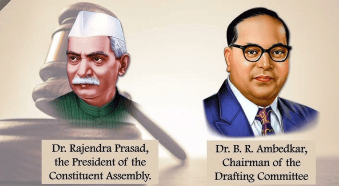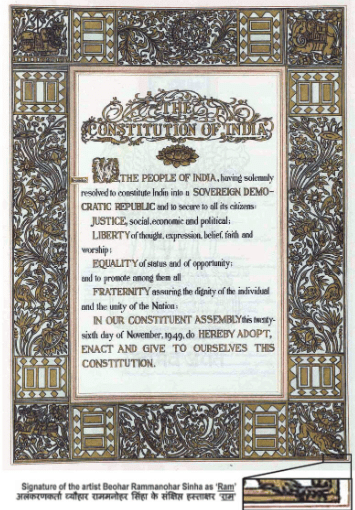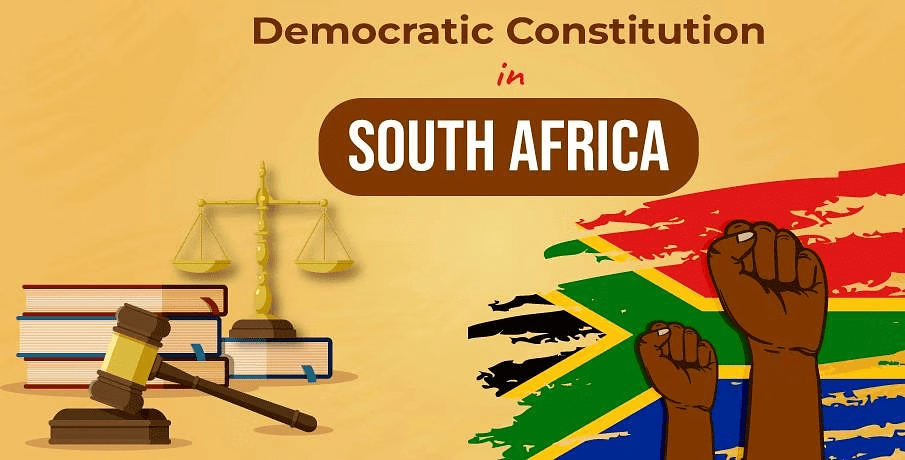Unit Test (Solutions): Constitutional Design | Social Studies (SST) Class 9 PDF Download
Time: 1 hour
M.M. 30
Attempt all questions.
- Question numbers 1 to 5 carry 1 mark each.
- Question numbers 6 to 8 carry 2 marks each.
- Question numbers 9 to 11 carry 3 marks each.
- Question numbers 12 & 13 carry 5 marks each.
Q1: Who was the Chairman of the Drafting Committee of the Indian Constitution?
Ans: Dr. B.R. Ambedkar
Dr. B.R. Ambedkar was the Chairman of the Drafting Committee, which was responsible for drafting the Indian Constitution.
Q2: Which of the following is a feature of the Indian Constitution?
(i) It is rigid.
(ii) It is flexible.
(iii) It is unwritten.
(iv) It is based on common law.
Ans: (ii) It is flexible.
The Indian Constitution is known for its flexibility, allowing amendments to be made to adapt to changing circumstances while still maintaining a strong framework of governance.
Q3: What does the Preamble of the Indian Constitution emphasize?
(i) Sovereignty
(ii) Socialism
(iii) Secularism
(iv) All of the above
Ans: (iv) All of the above
The Preamble of the Indian Constitution emphasizes sovereignty, socialism, secularism, democracy, and other core values that form the foundation of the Constitution.
Q4: The Constitution of India was adopted on __________.
Ans: 26th November 1949
The Indian Constitution was adopted by the Constituent Assembly on 26th November 1949, and it came into effect on 26th January 1950.
Q5: Which of the following values is NOT mentioned in the Preamble of the Indian Constitution?
(i) Liberty
(ii) Justice
(iii) Equality
(iv) Democracy
Ans: (iv) Democracy
While democracy is a fundamental aspect of the Indian Constitution, the Preamble specifically mentions values like Liberty, Justice, Equality, and Fraternity.
Q6: Why do we need a Constitution in a democratic country?
Ans: i) Establishes Basic Rules: The Constitution provides a framework of laws and principles that govern the country, ensuring that
everyone follows the same rules.
ii) Protects Citizens' Rights: It safeguards the rights of citizens and defines the powers and responsibilities of the government to prevent misuse of power.
Q7: What was the significance of the 'Tryst with Destiny' speech given by Jawaharlal Nehru?
Ans: i) Marking Independence: Nehru's speech marked the moment when India gained independence from British rule, symbolizing the end of colonialism and the birth of a free nation.
ii) Vision for the Future: The speech outlined the challenges ahead and the responsibilities of building a just and equitable society, laying the foundation for the new India.
Q8: What is meant by the term 'Secular' in the context of the Indian Constitution?
Ans: i) Equal Respect for All Religions: Secularism in the Indian Constitution means that the government does not favor any religion and treats all religious beliefs and practices with equal respect.
ii) Freedom of Religion: It ensures that every citizen has the right to practice, profess, and propagate any religion of their choice without discrimination.
Q9: Discuss the role of the Constituent Assembly in the making of the Indian Constitution.
Ans: i) Representative Body: The Constituent Assembly was a body of elected representatives responsible for drafting the Indian Constitution, representing the diverse population of India.
ii) Inclusive Deliberations: The Assembly included members from different social, linguistic, and religious backgrounds, ensuring that the Constitution reflected the aspirations of all Indians.
iii) Systematic Process: The Assembly worked systematically, forming various committees, debating clauses, and incorporating amendments, resulting in a comprehensive and inclusive Constitution.
Q10: What were the challenges faced by the makers of the Indian Constitution?
Ans: i) Diversity: India’s vast diversity in terms of religion, language, and culture posed a challenge in creating a constitution that would be acceptable to all.
ii) Partition: The Partition of India in 1947 created communal tensions and violence, adding complexity to the task of constitution-making.
iii) Princely States: The integration of over 500 princely states into India and ensuring their cooperation in the constitutional process was a significant challenge.
Q11: Explain the significance of the Preamble in the Indian Constitution.
Ans: i) Introduction to Constitution: The Preamble serves as an introductory statement that outlines the guiding principles and values on which the Indian Constitution is based.
ii) Reflects Aspirations: It reflects the aspirations of the people of India, emphasizing values such as Justice, Liberty, Equality, and Fraternity.
iii) Guiding Framework: The Preamble acts as a guiding framework for interpreting the Constitution and ensures that all laws and policies align with the fundamental values of the nation. 
Q12: Describe the major features of the Indian Constitution that make it one of the longest and most detailed constitutions in the world.
Ans: i) Comprehensive Document: The Indian Constitution is one of the longest in the world, with detailed provisions covering various aspects of governance, fundamental rights, and duties. It encompasses over 450 articles, multiple schedules, and numerous amendments, making it exhaustive in nature.
ii) Federal Structure: It establishes a federal structure with a clear division of powers between the central and state governments, ensuring a balance of power. This division is designed to accommodate the diverse needs of different regions and communities within the country.
iii) Fundamental Rights and Duties: It enshrines Fundamental Rights, protecting individual liberties and equality, while also listing Fundamental Duties that citizens are expected to follow. This dual approach ensures that citizens are aware of their rights while also recognizing their responsibilities towards the nation.
iv) Directive Principles: The Directive Principles of State Policy guide the government in making laws that aim to create social and economic conditions for a just society. These principles act as a framework for the government to formulate policies aimed at achieving socio-economic justice.
v) Provision for Amendments: The Constitution includes provisions for amendments, allowing it to evolve with changing times and societal needs. This adaptability is crucial for maintaining relevance and ensuring that the Constitution can respond to new challenges and aspirations of society.
Q13: Discuss the process of constitution-making in South Africa and how it led to the creation of one of the most democratic constitutions in the world.
Ans: i) End of Apartheid: The constitution-making process in South Africa began after the end of apartheid, a system of racial segregation and discrimination enforced by the white minority government. The dismantling of apartheid paved the way for a more inclusive and representative political system.
ii) Inclusive Negotiations: The process involved inclusive negotiations between the white minority and the black majority, ensuring that all racial groups were represented. This was a crucial step in fostering trust and collaboration among the diverse communities in South Africa.
iii) Reconciliation and Forgiveness: The leadership, particularly Nelson Mandela, emphasized reconciliation and forgiveness, focusing on building a nation based on equality and democracy rather than revenge. This approach aimed to heal the divisions of the past and promote national unity.
iv) Comprehensive Rights: The new constitution provided extensive rights to all citizens, including social, economic, and political rights, and ensured equality before the law. This comprehensive framework laid the groundwork for protecting individual freedoms and promoting social justice.
v) Model for Democracy: The South African Constitution is considered a model for democracy, with its emphasis on human rights, social justice, and the inclusion of all racial and ethnic groups in the governance process. Its democratic principles serve as an inspiration for other nations striving for equality and human rights. 
|
55 videos|525 docs|78 tests
|
FAQs on Unit Test (Solutions): Constitutional Design - Social Studies (SST) Class 9
| 1. What are the key features of the Indian Constitution? |  |
| 2. Why is constitutional design important for a democracy? |  |
| 3. How does the Indian Constitution protect fundamental rights? |  |
| 4. What is the significance of the Directive Principles of State Policy in the Indian Constitution? |  |
| 5. How does federalism function in the Indian constitutional framework? |  |
















